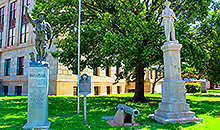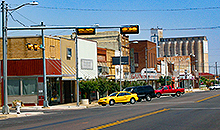Main Menu
Wilbarger County Data
Wilbarger County Communities & Places
Genealogy & History Links by USGHN
Important Wilbarger County Addresses
Sponsors
Wilbarger County Neighbors
Archer County, Texas Genealogy & History Network
Baylor County, Texas Genealogy & History Network
Foard County, Texas Genealogy & History Network
Hardeman County, Texas Genealogy & History Network
Jackson County, Oklahoma
Tillman County, Oklahoma
Wichita County, Texas
Other Websites
Welcome to Wilbarger County Texas Genealogy & History Network!
Welcome to the Wilbarger County, Texas Genealogy & History Network. Our purpose is to provide visitors with free resources for genealogical and historical research. To share your genealogy or history information, send an email to txghn@outlook.com and we will happily include it here. For other Texas Counties, visit the Texas Genealogy & History Network state website and go to the appropriate county. Thanks for visiting and good luck with your research! |
|
About Wilbarger County, Texas...

Wilbarger County is in northern Texas, along the Oklahoma border. Vernon, the county's seat of government and largest city, is thirty-five miles northwest of Wichita Falls. It encompasses rolling plains surfaced by sandy, loam, and waxy soils that support tall grasses, mesquite, and shinnery oak trees. The area is drained by the Red and Pease rivers. Mineral resources include volcanic ash, sand, gravel, and bituminous coal.
The area that is now Wilbarger County was part of the buffalo hunting ground of the Wanderers Band of Comanches until the 1870s. Wilbarger County was established in 1858 from lands formerly assigned to the Bexar District. It was named for settlers Josiah P. and Mathias Wilbarger. Though the area was within the boundary of the Peters colony, because of Indian hostilities it attracted no settlers until 1878, when the first settlement was made and the county was attached to Clay County for judicial purposes. C. F. and J. Doan, the first settlers in the area, established Doan's Crossing and Store where the Western Trail crossed the Red River. C. F. Doan became the county's first postmaster in 1880 after buffalo hunters, cattlemen, and Indians settled near the store, and mail lines to Wichita Falls, Mobeetie, and Seymour were soon opened.
 Mrs. A. T. Boger held classes for schoolchildren in a dugout east of Vernon in 1879, and by the next year a school had been built. W. B. Worsham established the R2 Ranch with headquarters at Big Spring in 1879. Settlers who lacked livestock made a living poisoning coyotes for their hides. Gathering buffalo bones for eastern fertilizer plants was another source of income. The county's tall sage grass supported antelope, deer, buffalo, wild turkey, and prairie chickens, and in season the land offered wild plums, grapes, currants, persimmons, and pecans for the taking.
Mrs. A. T. Boger held classes for schoolchildren in a dugout east of Vernon in 1879, and by the next year a school had been built. W. B. Worsham established the R2 Ranch with headquarters at Big Spring in 1879. Settlers who lacked livestock made a living poisoning coyotes for their hides. Gathering buffalo bones for eastern fertilizer plants was another source of income. The county's tall sage grass supported antelope, deer, buffalo, wild turkey, and prairie chickens, and in season the land offered wild plums, grapes, currants, persimmons, and pecans for the taking.
Wilbarger County was organized in 1881, and the town of Vernon was designated the county seat. The county grew quickly during the 1880s. In 1886 the Fort Worth and Denver City Railway built into Vernon, connecting the county to outside markets and encouraging immigration. The importance of the railroad to early development was recognized by local ranchers, who had donated rights of way. Relations with Indians were friendly during the 1880s. Quanah Parker and his Comanche followers visited the Doan family frequently, and Comanche-Kiowa Indians from Oklahoma marketed in Vernon with their government allotments in the 1880s.
A newspaper, the Vernon Weekly Call, was established in 1889. By 1890 there were 720 farms and ranches, encompassing almost 313,000 acres in Wilbarger County. Ranching had become important, and  almost 23,000 cattle and 21,000 sheep were reported that year. But crop farming was also becoming fairly well established in the area. Poultry raising was also becoming a significant part of the economy.
almost 23,000 cattle and 21,000 sheep were reported that year. But crop farming was also becoming fairly well established in the area. Poultry raising was also becoming a significant part of the economy.
Many farmers and ranchers suffered reverses during the 1890s. By 1900 almost all the county's sheep had disappeared, only 636 farms remained. Nevertheless, crop acreage expanded significantly during this time. The agricultural economy rapidly expanded between 1900 and 1920 as hundreds of new farmers moved into the area. As old ranch lands were converted to crops, the number of cattle declined, and by 1920 there were only 10,000 cattle in the county.
The population grew rapidly during this period. By 1930 almost 166,000 acres were planted in cotton, while only 1,400 acres were devoted to wheat and 8,000 acres to corn. There were 2,139 farms that year, 1,717 of which were operated by tenants. The 1920s also saw the rise of the petroleum industry. The first oil well in the county had been drilled in 1908, and a producing well followed in 1915, but significant production awaited the drilling of the South Vernon field in 1923. Soon the oilfield was extended across much of the south part of the county from the Wichita county line west through the Flukman field.
 The cotton economy was devastated during the Great Depression of the 1930s. Though cotton production remained a significant part of the economy after the depression, it would never again so be so dominant as before. The rapidly developing petroleum industry helped to offset some of these losses. Agriculture revived during the 1940s, and by 1950 more than 236,000 acres of cropland were harvested in Wilbarger County; almost 105,000 acres were planted in wheat that year. Farm consolidations and the mechanization of agriculture combined to drive down the number of farms and continued to push tenant farmers off the land. By 1959 there were only 873 farms, and of these only 340 were operated by tenants. Meanwhile cattle again became important to the economy. Almost 41,000 cattle were reported in 1950 and more than 30,000 in 1959.
The cotton economy was devastated during the Great Depression of the 1930s. Though cotton production remained a significant part of the economy after the depression, it would never again so be so dominant as before. The rapidly developing petroleum industry helped to offset some of these losses. Agriculture revived during the 1940s, and by 1950 more than 236,000 acres of cropland were harvested in Wilbarger County; almost 105,000 acres were planted in wheat that year. Farm consolidations and the mechanization of agriculture combined to drive down the number of farms and continued to push tenant farmers off the land. By 1959 there were only 873 farms, and of these only 340 were operated by tenants. Meanwhile cattle again became important to the economy. Almost 41,000 cattle were reported in 1950 and more than 30,000 in 1959.
Petroleum production grew rapidly during the 1950s and early 1960s, but then began to decline. Production increased from 3,176,000 barrels in 1948 to 6,011,000 barrels in 1965. The oil and gas industry remained important to the economy during the 1970s and 1980s. By January 1, 1991, 252,208,000 barrels had been produced in the county since 1915.
In 1982 approximately 93 percent of the land was in farms and ranches; about 41 percent of the farmland was cultivated, and 9 percent was irrigated. About 69 percent of the agricultural income was from crops, especially wheat, cotton, hay, oats, and guar. Watermelons were also grown. Cattle and hogs were the county's primary livestock. Industries included meat packing and the manufacture of resins, plastic material, and men's clothing.
 The county has a total area of 978 square miles, of which 971 square miles is land and 7 square miles (0.7%) is water. The population recorded in the 1880 Federal Census was 126. It peaked in 1930 at 24,579. The 2010 census recorded 13,535 residents in the county.
The county has a total area of 978 square miles, of which 971 square miles is land and 7 square miles (0.7%) is water. The population recorded in the 1880 Federal Census was 126. It peaked in 1930 at 24,579. The 2010 census recorded 13,535 residents in the county.
Neighboring counties are Tillman County, Oklahoma (north), Wichita County, Texas (east), Baylor County, Texas (south), Foard County, Texas (west), Hardeman County, Texas (west), and Jackson County, Oklahoma (northwest). The county seat is Vernon. Other communities in the county include Harrold, Hoot and Holler Crossing, Odell, and Oklaunion.
Wilbarger County, Texas Records
Birth Records - The Texas Department of State Health Services has records from 1903 to present. Records for the last 75 years considered private and will only be provided to certain individuals. To obtain current information on who may obtain a record, how to submit a request and an official request form, see the Texas Department of State Health Services website or write to Texas Vital Records, Department of State Health Services, P.O. Box 12040, Austin, TX 78711-2040.
For older birth records you will have to write to the County Clerk of the applicable county. The existence of birth records prior to 1903 will vary widely from county to county. Local historical societies and genealogy collections in local libraries may be able to provide some information.
Death Records - The Texas Department of State Health Services has records from 1903 to present. Records for the last 25 years considered private and will only be provided to certain individuals. To obtain current information on who may obtain a record, how to submit a request and an official request form, see the Texas Department of State Health Services website or write to Texas Vital Records, Department of State Health Services, P.O. Box 12040, Austin, TX 78711-2040.
Marriage Records - The Texas Department of State Health Services can provide a verification letter of marriage for Texas marriages from 1966 to present. This is NOT a marriage license. To obtain a certified copy of a marriage license you must contact the County or District Clerk in the county or district where the marriage took place.
Local historical societies and genealogy collections in local libraries may be able to provide some information.
Divorce Records - The Texas Department of State Health Services can provide a verification letter of divorce for Texas divorces from 1968 to present. This is NOT a copy of the divorce decree. To obtain a certified copy of a copy of the divorce decree you must contact the County or District Clerk in the county or district where the divorce took place.
Local historical societies and genealogy collections in local libraries may be able to provide some information.




